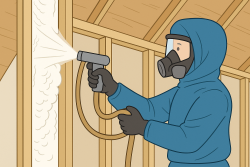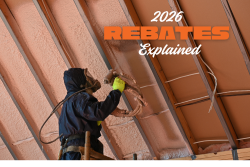The right balance of ventilation and insulation is the key to a comfortable and healthy house. Insulation protects your home’s interior from the elements and is an effective way to reduce the likelihood that high humidity, leaky pipes or a compromised roof will cause severe water damage. Moisture accumulation damages your walls, threatens the structural integrity of the building and leads to mould growth and rot. Here’s what you need to know about blow-in insulation and how it can help protect your home.
What is blow-in insulation?
This refers to any insulation that can be blown inside an existing wall cavity. The most commonly used materials for blown insulation are styrofoam pellets, loose fibreglass fibres and cellulose.
Cellulose is especially effective at preventing moisture damage. It’s made from recycled materials like newspaper, cardboard, and wood waste. These materials are treated with boric acid to provide superior flame resistance. Boric acid also has insecticide and antiseptic properties and is a safe and reliable mould inhibitor.
Cellulose is one of the greenest options on the market and can be quickly and easily added to existing homes without damaging finished walls.
How are blow-in options different from other insulating materials?
Fibreglass rolls or batting are the most common type of insulation in Canada. Batting is a light, fibrous material made from glass or rock that rests in between wall joints to provide thermal insulation. While batting is a less expensive material, it can’t be installed without tearing out the existing drywall.
Insulation materials that can be blown into a wall cavity provide superior air-sealing. They also insulate areas in and around obstacles found in the wall, like pipes and wiring. Contrary to rolls or batting, they can easily be added to an existing home with minimal impact on finished walls.
How can blow-in insulation minimize moisture damage?
Blown-in insulation can help minimize water damage by providing a barrier between your building’s exterior and interior walls. This type of insulation creates a high-density layer of protection that restricts airflow and significantly reduces the risk of condensation and moisture accumulation. Keep in mind, however, that no type of insulation can completely prevent moisture issues from occurring.
Expert contractors in Southern Ontario
For more information about cellulose and other types of insulation, visit Reitzel Insulation. With over 46 years of industry experience and three offices across Southern Ontario, we have the expertise to handle all your residential and commercial insulation needs. Contact us today to learn more about our services or to schedule a visit.

















